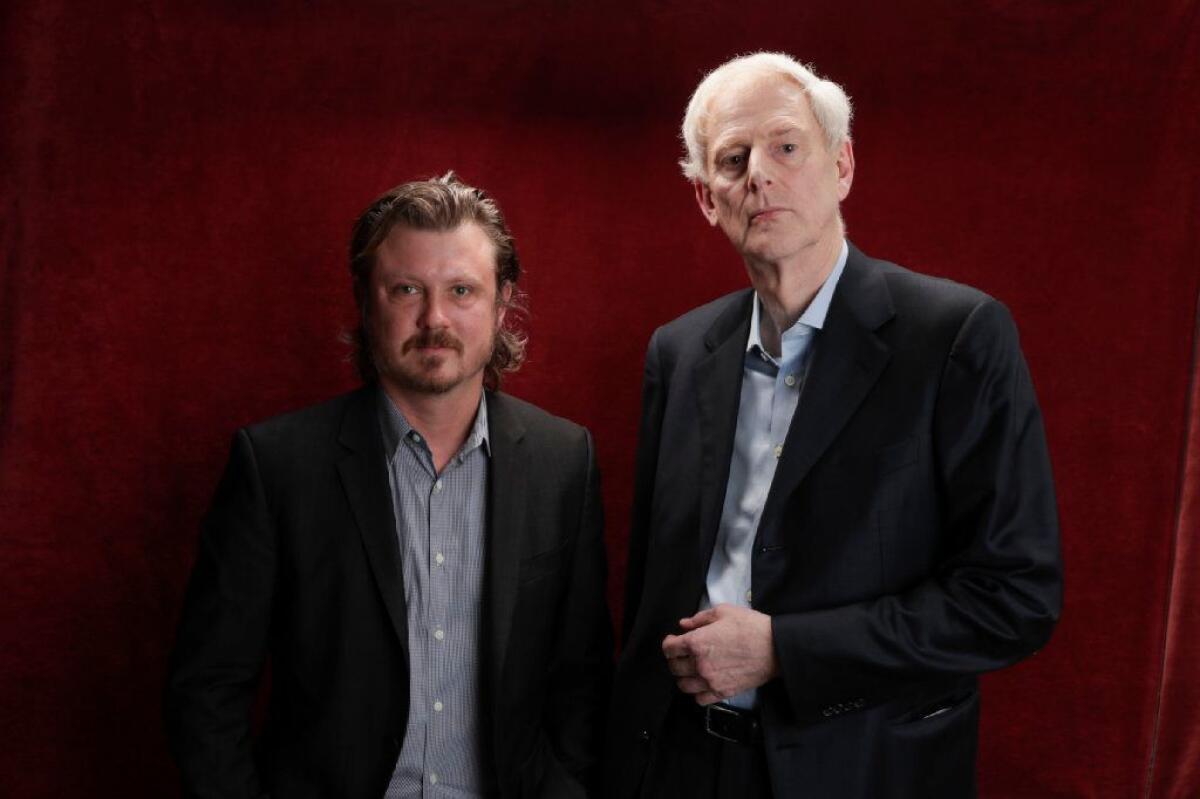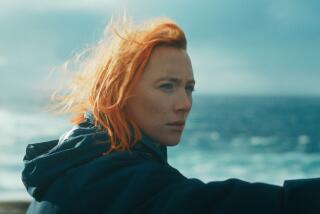How historian John Guy and Beau Willimon of ‘House of Cards’ read between the lines of history to rewrite ‘Mary Queen of Scots’ legacy
- Share via
For centuries, history had not been kind to Mary Stewart, Queen of Scots — a mistreatment that director Josie Rourke aimed to correct with her revisionist 16th century drama “Mary Queen of Scots.”
Vilified by the enemies who orchestrated her downfall and beheaded for treason at the age of 44, Mary’s legacy had been written by those who had schemed against her, some modern day historians argue.
For the record:
10:45 a.m. Dec. 21, 2018This article misspells Mary Stuart’s last name as Stewart.
Also greatly misunderstood and overlooked, according to Rourke’s debut film, were the intertwined sympathies of the headstrong Mary (Saoirse Ronan) and her cousin Queen Elizabeth I (Margot Robbie), lone female rulers in a turbulent era rife with murder, betrayal, and conspiracies galore.
At the helm of the Working Title and Focus Features production which is steadily expanding across the country after a strong debut in four theaters over the first weekend of December, British stage veteran Rourke tapped a key collaborator to help rewrite Mary and Elizabeth’s history for the screen: former “House of Cards” showrunner Beau Willimon, whose screenplay pulses with political intrigue, poignant speculation and deep emotion.
“What really drew me to this story was how modern these women are; they were so far ahead of their time and have so much to say about the here and now,” said Willimon; “Mary Queen of Scots” marks his second produced film as writer since his Oscar-nominated adaptation of the 2011 George Clooney political thriller “The Ides of March” from his own play. “We keep returning to enduring stories, and their story has endured for almost 500 years.”

Willimon, in turn, looked to a leading expert on the era: John Guy, whose acclaimed 2004 book on Mary provided a valuable blueprint for telling a previously untold version of her life. Willimon sought to contextualize not only the religious and political forces hovering around Mary and Elizabeth, but also the personal challenges both queens might have faced as female leaders in a time of systemic misogyny.
While researching a BBC series on Mary years ago, Guy, an expert on Tudor England, discovered documents that shifted his perspective on how history remembered Mary Stuart — and the evidence implicating her in the plot against frenemy queen Elizabeth that led to her execution.
“Mary was as much the victim of the pen as the executioner’s axe; her enemies stole her story,” said Guy. “They were determined not just to write it down for the time in which they lived, but for posterity.”
The British scholar and historian describes his approach as somewhat scientific, his method “forensic.” He speaks of the past in the present tense, a habit that tends to lend historic happenings a rush of immediacy, whether they occurred 15 years or five centuries ago, and which also makes events of long ago feel like they only just happened yesterday.
“I go to the archives, I look at these documents — and I realize that I’m not seeing the story that’s come down,” said Guy, joining Willimon for a chat on a recent day in Beverly Hills. “So I get interested and I just latch onto this — all the furniture moves around, and you have a different pattern.”
Among the archival materials he found were correspondences credited to Mary, including letters that became ammunition for the assassination of her character, and worse. “Partly genuine, partly forgeries, with bits added on – in one case actually doctored, with words crossed out, by [Elizabeth’s advisor] William Cecil himself, to make it much more incriminating to Mary.”
“I suddenly realized that you’ve got to start all again, so that’s just what I did,” said Guy, who would go on to write his discoveries into his award-winning book “Queen of Scots: The True Life of Mary Stuart.”
He gathered as much material as he could from archives in France, where Mary was raised, in Scotland where she returned to rule at the age of 19, and in England, where her life ended, as well as resources in the United States.
“And I realized that both Elizabeth and Mary — or as it might whimsically be said, both fully paid up members of the Women Monarchs Trade Union — were actually on each other’s side as women rulers,” said Guy.
Both of their stories had to be rewritten, he says, with a modern understanding of how the simple act of being women in positions of power in a patriarchal society made both queens’ lives a battle from the start.
Which is exactly what Rourke and Willimon set out to do.
As Rourke’s film tells it, young Mary Stuart was bold and rebellious, charming and affectionate, her liberalism likely owing to her upbringing in the French court. She was a queen made great by her humanity.
Her generosity is embodied in some of Ronan’s warmest scenes, in which Mary shares laughter and tears with her ladies in waiting, forgives her own confidant David Rizzio for his dalliance with her new husband, Lord Darnley — and is shattered when her own conspiring countrymen murder Rizzio in front of her on trumped-up charges.
One of Willimon’s favorite moments in the film finds Mary, astride her horse and literally ready for battle, taking the time to speak with her soldiers before leading them into a fight.
“In those moments, you can see her human compassion for another human being,” said Guy. “That’s something you would not see, ever, with Elizabeth. Elizabeth did not have that sort of compassion for others. She was very good at writing letters of condolence, but [not] in terms of actual face to face contact, or touching somebody, or cradling their head.”
“And yet, we do see compassion in her — it’s a different sort,” countered Willimon. “If you read between the lines in her correspondence, I think you see a desire to connect with Mary and to see her as an equal and a compatriot, and wanting to sort of find a way to coexist together.”
In a film that ambitiously attempts to reconstruct the human shards of the past that have been largely left out of the historical record, “Mary Queen of Scots” builds up to a dramatic meeting in a remote wash house between Mary, now a fugitive from her own throne hiding in the English countryside, and the powerful cousin whose protection she needs.
Each has made her own hard choices over motherhood and marriage. Each has sacrificed, loved and lost. After sharing mutual respect, fear, jealousy, frustration and sisterhood from afar their whole lives, the duo finally comes face to face in a masterfully tense pas de deux, each at last seeing the other as she truly is.
It’s a moment in which “Mary Queen of Scots,” fueled by powerful performances from Ronan and Robbie, most vividly illustrates the invisible forces that pushed and pulled the queens in different directions. It shows how tragic it was that they sacrificed so much in service to their crowns, neither allowed to live fully or freely.
To the dismay of some historians and strict history buffs, it never actually happened. That’s just fine by Guy.
“That was entirely your creation,” he said, turning to Willimon. “But I think it would have ended the way that Beau has scripted and Josie has directed it, and for my money that is true to history in the broadest sense of the essential truth here.”

Saoirse Ronan and Margot Robbie star in “Mary Queen of Scots.”
What the British historian and the Hollywood screenwriter share in common in their respective work, they agree, is the pursuit of that truth, each acting in their own way as emotional investigators excavating recorded history to give voice to these women.
“Great history requires great imagination,” said Willimon of Guy. “A document is just a document; you have to try to place yourself in the shoes of the person writing it. You have to imagine how it would have been read by the person receiving it. You have to look for intent between the lines, because oftentimes the language might be masking what someone’s really thinking or feeling.”
Willimon didn’t necessarily factor in the real world parallels that emerged in post-election America when he began work on the project — the similar themes in Mary and Elizabeth’s story that one might see, for example, in the ways that powerful female politicians and leaders are scrutinized and talked about today.
But, Willimon says, “All art is political.
“Any story is communicating a perspective, and that perspective is informed by one’s experiences and one’s political beliefs,” he said. “Sometimes you’re communicating it in an explicit way and other times you’re communicating it in a more oblique and implicit way, but if you’re speaking honestly and truthfully, you’re presenting a version of the world that is your own. And that version of the world is inherently political.”
“I’m a novice in this movie industry, but there’s got to be a story, a take, and contemporary relevance,” added Guy. “And the contemporary relevance then was the fact that Hillary Clinton was running for president — and people thought that she was probably going to win. Theresa May was the British prime minister, and Nicola Sturgeon was the chief minister of Scotland.”
Willimon says his hope for the film is that audiences see in Mary and Elizabeth’s stories valuable reflections of experiences and struggles that persist today.
“If they feel like this story is personal to them,” he said, “[that] this story of these two queens from 500 years ago has something to say to their own experience here in the present, then we will have achieved what we set out to do.”
ALSO
In ‘Mary Queen of Scots,’ a modern feminist spin on the frenemy queens who fought to rule Europe
Smear campaigns, political savvy and treacherous men: ‘Mary Queen of Scots’ as a mirror to today
More to Read
Only good movies
Get the Indie Focus newsletter, Mark Olsen's weekly guide to the world of cinema.
You may occasionally receive promotional content from the Los Angeles Times.











